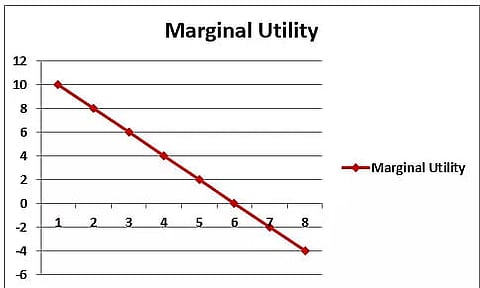
- Home
- Live Blog
- Breaking News
- Top Headlines
- Cities
- NE News
- Sentinel Media
- Sports
- Education
- Jobs

While studying economics in schools, colleges or management institutes one would have probably heard of the law of diminishing marginal utility. In this write up, we will go through the definition of the same in the economic term and we also throw some light about its various aspects.
What does Marginal utility means?
In simple terms, it refers to a change in total utility due to a one-unit change in the level of consumption. Economists often use this concept to measure how much of goods or items consumers are eagerly waiting to buy. It can be positive or negative.
After diving into the definition of this, let's have a look at the above mentioned topic.
The law states that as we use additional units of a product, the marginal utility extract from successive unit decreases gradually.
Now, for the better understanding let us understand few terms such as Total Utility and Marginal Utility.
Total Utility vs. Marginal Utility
Total Utility measures satisfaction which consumer gets it from consuming items, while Marginal Utility refers to a switch in satisfaction gained from consumption as a result of a change in consumption.
Mathematical formula:
MU(x) = TU(x) – TU(x – 1)
The Marginal Utility gained from the xth unit of consumption is equal to the difference between the total utility gained from x units of consumption and the total utility gained from x–1 units of consumption.
Example:
Assume that a hungry poor asked you for money to buy a water bottle to quench his thirst, but instead of giving money you prefer to provide him a glass of water. The aggregate satisfaction which the poor gained from a glass of water is directly proportional to poor's thirst level.
It means that the first glass of water will give the poor more satisfaction (utility) than the second, which in turn will give poor more satisfaction than the third water glass.
Now, from this example, we learned that each water glass reduces the poor's thirst level. The reduction in his thirst level results in less satisfaction from the water glass being consumed. Each glass of water decreases the quantity of satisfaction which he will get from the water glass that follows.
Marginal Unit types:
Positive marginal utility
Here, the total utility witness a jump whenever, there is an increase in consumption of extra units of a commodity.
Zero marginal utility
When total utility does not change after an increase in consumption of extra units of a commodity, it's called zero marginal utility.
Negative marginal utility
When total utility decreases with increase in consumption of extra units of a commodity, it's called a negative marginal utility.
Also read: Head & Shoulders Pattern in Stock Markets
Also watch: